
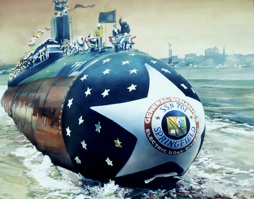

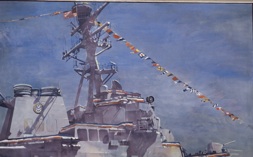
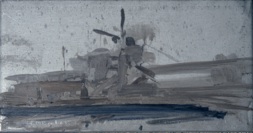
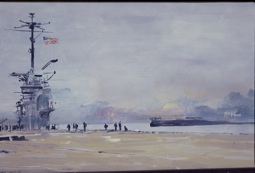
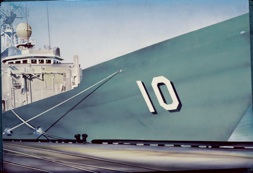
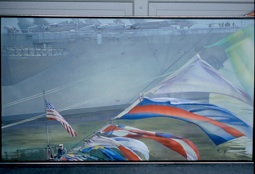
The Launch of the Springfield
40 x 50”
In the early hours of a new day, in the first days of a new year, a submarine was launched in Groton. Like a young salmon destined to live in the sea, Springfield’s birthplace was among small, bucolic inlets and streams. I expected to be impressed by the technology, but I was also fascinated by the contrast between it and its place of construction. I had no comprehension of the skills and dedication required to operate a submarine, and had a lot of learning to do. I found the lifestyle comparable to an artist’s, especially if she works with an airbrush. My studio is a long metal tube, windowless except for two overhead hatches, my skylights. It is partially soundproof and lightproof. With skylights shut, I delve into a realm of concentration. Not leaving for several days, I am surrounded by the hum of projectors, compressors, air filters. Smells of hot oil fill the air. I surface for supplies and repairs. Throwing open skylights I experience the joy of surfacing, warm sunlight, fresh air. Yet I always return to the depths, where I find concentration.
As Springfield slid into the twenty-first century, carrying with it the pride and skills of people of goodwill, early light illuminated the spires of the harbor of the little town. This is the moment I chose for my painting.
Harder
30 x 40”, each
In two panels this oil on canvas is a diptych. This very poignant painting is done as a memorial to the men who, on their sixth war patrol, were all lost, sunk by enemy surface craft. I chose to execute this work in two parts, to indicate the sudden breaking in half, leaving the tapes on, as metaphor of fragility, paradoxically, the color is serene.
Gray Ghost Towed to Alameda
50 x 77”
Early one May morning honored guests gathered at NAS Alameda, waiting excitedly to don flight gear, hear roll call, and board a military helicopter. As we were then flown across the bay and landed on WWII carrier Hornet. As a female civilian two days short of a birthday that would land me well into middle age, I couldn’t help but thrill to how I cheated father time, strapped down on a long canvas bench, not a seat, blending in, in my helmet and flight vest, with the young crew members. The short and exciting flight ended with a steep decent onto the ghost deck of an old war hero. Its aspect was forlorn waiting on the slaughter dock in the gray weather the Navy aptly terms “blowing spit”, waiting in decomposing and decommissioned Hunter’s Point. Captain Dodge had somehow found out they were behind schedule in dismantling the old hero, and had moved mountains to allow it to be towed to Alameda. There, it was hoped, it would provide an historic platform for the summer’s base closure events. In storage over fifty years yellow foam eerily protected its solid teak decks. Fog shrouded its rusting superstructure. Said superstructure was also dotted with seagulls nests. The time had come. The Crowley Tug Saturn whistled and omitted a mighty plume of smoke as powerful engines roared alive. Imperceptibly at first, faster with the growing momentum of its mighty mass, Hornet was headed home.
In the Estuary #9 5 x 9” on aircraft metal
A companion piece to #7, #9 was made under the same conditions and of the same material and the same afternoon. Inspired by the Cape Mohican as seen from Hornet’s fantail as it was undergoing repairs, as part of the mothball fleet, for new service, supporting our Nave and Merchant Marines across the oceans of the real world. The same general conditions of a muddy estuary in the fog prevail. The scratches and surface incident that mark the life of this little piece of aircraft metal become interwoven with the subject, the character of the material adding life, vintage, and history to the piece.
Amazing Grace 36 x 59" oil on linen
On September 6, 1997 I was invited to the commissioning of the USS Hopper (DDG 70) Motto: Dare and Do. This was a joyous occasion, amid base closures, especially as this ship is named for Rear Admiral Grace Hopper, the remarkable great great granddaughter of Admiral Alexander Wilson Russell. The Phi Beta Kappa (Vassar ’28) also received a Master of Math and Physics degree, Yale, taught at Vassar, and attended USNR Midshipmen’s School, Northampton, MA. Upon graduating she participated in the bureau of Ordinance Computation Project, Harvard. There she learned to program the first large-scale computer, the Mark 1, for the Navy. It is Grace Hopper who coined the term “bug” after restoring the Mark 1 to service by removing a moth from its switching contacts. The incredible Rear Admiral is the woman who computerized the Navy. The ship is affectionately known as the “Amazing Grace”, and it’s the joy of her achievement, expressed in the jaunty flags and good wishes on Commissioning Day that I hoped to capture in this work.
Ten
Ten is a painting of the USS Duncan, FFG-10. I was taken by the gray shape, shark-like in it’s simplicity, from that angle. I usually name the painting after it’s subject but this was made when the movie “10” was popular and the temptation was irresistible.
Ten was also my entrée into the world of the military marine painting. Serendipitously, it came to the attention of Rear Admiral Tedeshi, now retired. Ten was his first command. As of 1996 Ten was sold to a foreign nation in South America.
Flags, Fleet Week
28 x 50”
Flags, Fleet Week has always been a bright spot in my mind, a time when I was able to leave the studio and walk out with my camera along San Francisco’s beautiful waterfront. One fleet week I mingled with the crowds enjoying the sights and sounds of early October when weather here is glorious. It was then that I observed an intimate moment, the captain out to inspect and approve the festive flags adorning his command. A happy and proud moment no doubt in his career all seen against the dwarfing bulk of an aircraft carrier, also tied up and waiting to greet the public.